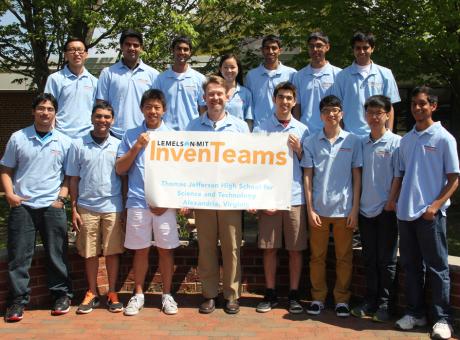Thomas Jefferson High School for Science and Technology InvenTeam
Today's environment can be harmed by myriad factors, including agricultural runoff, industrial waste and sewage, which can all cause poor water quality. Detrimental effects can even be caused by electricity. The Thomas Jefferson High School for Science and Technology InvenTeam decided to find a way to simultaneously produce clean water and energy. The students focused on Microbial fuel Cells (MFCs), which convert chemical energy into electrical and mechanical energy. The fuel cells react to water and synthesize it, which allows the water to be used for many applications. The team's first MFC prototype was a single-chamber model with two hollow plates attached on either end of a hollow tube. One of the most efficient models uses ceramic cups as the ion-exchange medium to facilitate prolonged power generation. The inside of the cup holds the ferricyanide cathode solution. The cup is placed in the center of a 400-mL beaker. Each compartment contains one graphite rod. Anodes are connected with alligator clips, with a 1,000-? resistor in series. A parallel circuit is connected to a computer program that measures voltage as a function of time. The students decided to create a fuel cell, because they wanted their project to focus on electrochemical applications for environmental improvement and create a source of clean energy. In the first model created, the tube kept cracking. So, the students created a second model using a three-piece design and a more durable material. The edges were very rough, because they had to use a jigsaw on the plates; hence, they created another model using a milling saw. They received help from Penn State mentor Dr. Bruce Logan, a leading researcher in MFCs. The team also worked with Mrs. Joan Ozdogan of the Thomas Jefferson Partnership Fund, who helped with project development and obtaining external support and collaborators. The team created three research groups, the Chemical Analysis group, the Biotechnology and Engineering Materials Laboratory group, and the Prototyping groups. The Biotechnology group cultured the microorganisms and worked on all biological aspects of the invention. The Chemical Analysis group worked on water testing, chemical processes, and design of the fuel cell. The Prototyping and Engineering group looked at various design methods used to create MFCs and created practical models from the findings of the Chemical Analysis group. The Thomas Jefferson High School for Science and Technology InvenTeam hopes to continue experimenting to create a Microbial Fuel Cell with commercial purposes. MFCs are expected to greatly reduce the cost of wastewater treatment and supply power. The students hope to work with a local water treatment center to improve their cells and then work on manufacturing, installation and upkeep.


